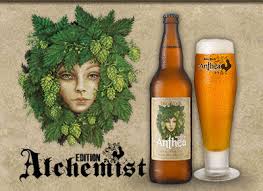 I appreciate fresh hop beer, often called wet hopped, as in general these beer bring out hop characteristics I enjoy. I find the hop flavour to be fuller, less harsh and the bitterness more rounded. In a well-made fresh hop beer, you can taste the cone leaves. So, you can imagine I was looking forward to trying Big Rock’s first foray into the wet hop world when it came out a few weeks back.
I appreciate fresh hop beer, often called wet hopped, as in general these beer bring out hop characteristics I enjoy. I find the hop flavour to be fuller, less harsh and the bitterness more rounded. In a well-made fresh hop beer, you can taste the cone leaves. So, you can imagine I was looking forward to trying Big Rock’s first foray into the wet hop world when it came out a few weeks back.
They called it Anthea Wet Hop Ale, and only 3,600 bottles were made. Anthea is an alternate name for the Greek Goddess Hera, and literally translates to “blossom”. Big Rock claims the hops were picked less than 24 before being used in the brew. They also say they started mashing the beer while the hops were still in the air on their way to Calgary. That is pretty darned fresh!
Their attempt at fresh hop brewing is the latest in their efforts to step their game up, both in terms of process (e.g., their stein beer earlier this yeare) and ingredients (rosemary and other unusual additions) over the past year or so. Having Big Rock taking experimentation seriously is a good thing for all beer drinkers, even if someone doesn’t appreciate the results of their efforts. Big Rock’s reach and name recognition help lend credibility to experimental beer, in my opinion.
What of the beer, then? It is light copper and builds a rich, dense white head that deposits a gentle web of lacing. It has lovely clarity and, I must say, is a very attractive beer. The aroma is fresh and grassy which I would immediately identify as Cascade hops even if they hadn’t told me that ahead of time. Underneath the soft hop aroma I find some light toffee and some crisp burnt caramel. Overall the aroma isn’t as pronounced or as “fresh” as I hoped.
I take a sip and find the front continues with the light toffee theme, adding some crystal malt notes and a grainy edge. The hop flavour kicks in rather quickly. I pick up an earthy, viny character that is more like plant than hop. I can also detect the hop green mass in the flavour. The bitterness is deceptive. At first seems too low, but slowly builds over a couple of sips until it presents a nice, fresh, earthy bitterness that smacks of hop cones. The body has a silkiness that contributes to the sneakiness of the hops, masking the bitterness at first.
While Big Rock does not admit to a style, I regard this a pale ale with a distinct Cascade character. The first sip is deceptive, seeming like the IBUs aren’t there and the hop a bit too harsh. However, the bitterness rises over time, showing itself to be in the zone. I like the soft, rounded nature of the bitterness. However the linger also offers a sharp green vegetation note, which is not entirely pleasant. They may have imparted a bit too much of the character of the cone itself – such is the risk of fresh hopping.
Overall, I enjoyed the beer. As expected the freshness offers a new dimension to the beer which makes it interesting through to the bottom of the glass. While head brewer Paul Gautreau may not have fully exploited the potential of the harvest fresh hops, he is in the right zone. The base beer complements the fresh hop well, and there is a great deal of potential for this recipe, should they choose to brew it again next year, maybe with a larger aroma addition. It would also be fun, in my opinion, to get the same beer released simultaneously with standard hopping and with fresh hops to really draw out the effects of using fresh hops.
Just a thought.


Leave a Reply